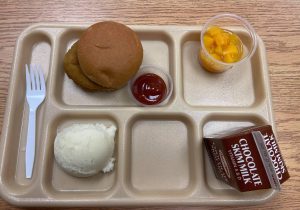A few weeks back a teacher at my son’s school posted a picture of a typical school lunch in Fargo. This photo began to circulate around some social media groups with similar reactions of shock and disappointment.

I understood those reactions. To me, the meal looked boring, unsatisfying, and unhealthy. And I thought:
When was the last time I asked my kids how they liked school lunch?
I also saw this as an opportunity to connect with Cindy Hogenson, Fargo Public Schools (FPS) Nutrition Services Director (and a mother of three herself!) to learn more about school lunch in Fargo. Cindy spoke of school nutrition challenges and how decisions are made. She also touched on what collaborative efforts concerned FPS school families can make to support positive change.
Current Challenges
First, let’s call out the obvious in the situation. School looks very different this year and naturally, so does school lunch. Cindy mentioned that she and her team have had to navigate many barriers due to the COVID-19 pandemic. Here are some obstacles they have faced this school year.
1. Being Short-Staffed
Yes, the sweet older ladies we all remember from our school days are still the majority of people who work to serve our kids. But this year with COVID-19, many did not return because of the risks.
Those on staff are struggling after a long year, working short-handed, and they are tired. If you know someone who would feel comfortable working with kids a few hours a day (no weekends!) there are many open positions.
2. COVID-19 Restrictions
Imagine getting kids through the lunch line, six feet apart, wearing masks, not allowed to touch food or trays, and have them finish eating within 20 minutes.
The restrictions to maintain safety in the schools have made it extra hard this year for Cindy’s team. Their goal is to get kids through the lunch line safely, while still allowing enough time to eat.
Administration asked food services to simplify options and limit items to speed up the process. And schools have worked hard trying to figure out how to streamline efficiencies. It has required some effort. Just hearing Cindy tell me about all the work that went into planning how children were even going to receive their food made my head spin.
Another challenge was that public health had deemed any self-serve options (salad bar, share bin) not safe.
3. Food Supply
Due to the COVID-19 pandemic, there have been more issues with food supply. For example, Cindy said the meal planned for the day after our meeting included broccoli, but it never came. So she had to swap cucumbers, the vegetable for Wednesday to substitute for Tuesday. She had one day to figure out what veggie would be served to over an entire district.
And supply could become even more complex as huge districts on the West and East coast begin to open, and the demand for food supply goes up again.
4. Food Requirements
I asked Cindy to walk me through what other barriers are there even in a more “typical” year with no masks and restrictions.
I learned that the Obama Administration’s healthy eating requirements are still in place, requiring school food suppliers to modify food away from white starchy foods to “healthier” alternatives.
While the intention is meant well, the reality is that kids still don’t eat this way at home. For example, one of the focuses is to reduce sodium in food through phases. Lower sodium spaghetti sauce can be produced, but does not taste the same as what is being eaten in the home. This could be the cause of complaints from kids that school lunch doesn’t “taste good.”
Until Americans are ready to eat healthier inside their homes, it will be hard to convince kids to eat healthier foods at school.
The Value of School Meals
What has the experience of the COVID-19 pandemic taught us?
Mealtime is essential. We need to stand firm on the essential time for children to sit and eat food and have a meal. The current time limit on lunch goes by so quickly sometimes that kids are often too rushed to assess if they are still hungry. And sometimes they are forced to rush to eat all the food on their plate.
Pre-COVID, kids would come in the morning and choose between breakfast and recess. A tough choice for many kids who wanted to be with their friends. Since COVID-19 and the current offering of breakfast for all kids, it is now part of the daily routine. Cindy stated, “administrators are loving this… they are saying the mornings are more calm, kids are more calm, behaviors are down…most elementary schools are saying they want to continue to have breakfast as part of the day.”
I learned so much by taking an hour to sit down with Cindy to learn more about school lunch. First and foremost, healthy habits start at home. If we want kids to eat healthier at school, we need to eat healthier at home. Second, there have been some wins gained despite the unpredictable nature of the last year. The value of mealtime as a part of the school day is clear.
Get Involved
If you are interested in providing constructive feedback, Cindy invites anyone to reach out directly. If you feel passionate about school lunch time policies and the way food is offered, check in with your school administrators directly. Finally, reach out to your representatives, tell them what you want to see in school lunch policies and have an impact on the way the Cindy and her team receive support and direction from our state government.
Overall, we are all united in our goal to guide our children toward healthy choices and to work toward better overall health.
















